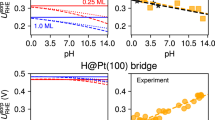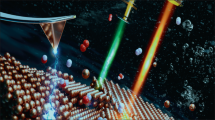Abstract
A critical view of interfacial electrochemistry in the past 50 years is discussed, with emphasis on tacit assumptions, which are sometimes hard to justify. The important role of the Tafel equation in studies of the mechanism of electrode reactions and in the development of electrode kinetics in the past century is recognized. However, it is shown that the validity of the ways it was implemented can be questioned, particularly in view of the uncertainty in the value of the symmetry factor commonly assumed. For example, the value of β pertinent to a species in the outer-Helmholtz plane cannot be the same as that applicable to a species already adsorbed on the surface. Three factors are involved in considering charge transfer to an adsorbed species: (a) The electrostatic field at the adsorption site is highly distorted; thus, the overpotential imposed may not apply at the point where the reaction takes place; (b) the effective charge on the adsorbed species may not equal the nominal charge assigned to it; and (c) the metal surface may already be modified by a monolayer of adsorbed species of the same kind, which is, however, inactive with respect to the reaction taking place. Similarly, in studies of the kinetics of metal deposition and dissolution, where charge is transferred across the interface by the ions, one cannot legitimately assume a value of β, although it can be measured experimentally. It is very risky to predict the future of interfacial electrochemistry, but one might extrapolate present trends. Thus, the importance of the fundamental aspects of the field may have declined in the past two or three decades, and this trend will probably continue. On the other hand, the importance of understanding interfacial electrochemistry as a basis for related fields such as nano-science, biology, micro- and nano-implanted biosensors, interaction of tissue with metal implants, materials science, as well as technologies such as corrosion and alloy plating is likely to increase.


Similar content being viewed by others
Notes
Politicians often like to use this logic when they lose an election, claiming that the minority may be right. They may indeed be right, but I have yet to see a politician who won the election adhering to this wise observation.
This does not apply to diffusion or solution resistance, for which the characteristic length may be a hundred micrometers or more.
The best advice for the experimentalist is to remove the tip of the capillary from the electrode surface far enough to eliminate the screening effect, since modern potentiostats enable electronic compensation for most of the residual solution resistance.
Note that this explanation is based on the tacit assumption that the Br− ion adsorbed maintains its charge. Even if this assumption is valid for the case of Hg, it may not be valid for other metals.
In the old literature, they were called “high-overpotential metals”. A better choice would be “low-exchange-current-density metals,” although this sounds rather cumbersome.
Removing the first water molecule would require more energy than the average because it represents transition from a stable form of a species to an unstable one, while removing the following water molecules represents changing from one unstable species to another.
This is a somewhat problematic statement because the hydrated ion could be considered as a complex, with water molecules as the ligands. The distinction can be justified by considering such “aqua-complexes” as the standard state because of their omnipresence in aqueous solutions.
Imagine what the number of citations of Prof. Tafel would be, if every paper in the past century mentioning his equation would cite the proper reference!
Take, for example, the discovery of the double-helix structure of DNA in 1954, which led to the routine use of sequencing in forensic laboratories, to identify a criminal by a very small sample of DNA he may have left behind.
References
Landau U, Weinberg NL, Gileadi E (1988) J Electrochem Soc 135:396
Frumkin AN, Pertii OA, Nikolaeva-Fedorovich NV (1963) Electrochim Acta 8:177
Fawcett WR (1969) J Electroanal Chem 22:19
Anson FC, Rodgers RS (1973) J Electroanal Chem 47:287
Weaver MJ, Anson FC (1975) J Electroanal Chem 58:81
Kashti S, Kirowa-Eisner E, Gileadi E (1975) J Electrochem Soc 65:401
Kashti S, Kirowa-Eisner E (1979) J Electroanal Chem 103:119
Gileadi E (2002) J Electroanal Chem 532:181
Gileadi E (2003) Interface 12(4):10
Gileadi E (2004) Chem Phys Lett 392:421
Gileadi E, Kirowa-Eisner E (2005) Corr Sci 47:3068
Gileadi E (2005) In: Fuller T, Bock C, Lamy C (eds) 5th international symp proton-exchange-membrane fuel cells. ECS transactions, vol 1(6), p 3
Gileadi E (2008) Isr J Chem 48:121
Gileadi E (2011) J Electroanal Chem. doi:10.1016/j.jelechem.2011.01.025
Eliaz N, Gileadi E (2008) In: Vayenas CG, White RE (eds) Modern aspects of electrochemistry, vol. 42. Kluwer, Dordrecht, pp 191–301
Osteryoung RA, Lauer G, Anson FC (1963) J Electrochem Soc 110:926
Osteryoung RA, Anson FC (1964) Anal Chem 36:976
Kirowa Eisner E, Bonfil Y, Tzur D, Gileadi E (2003) J Electroanal Chem 552:171
Kirowa-Eisner E, Tzur D, Gileadi E (2008) J Electroanal Chem 621:146
Hamelin A, Clavilier J, Velette G (1968) C R Acad d Sci Series C 7:435
Clavilier J, Faure R, Gunet G, Durand R (1980) J Electroanal Chem 107:205
Feliu JM, Fernandezvega A, Eldaz A (1988) J Electroanal Chem 256:149
Clavilier J, Fernandezvega A, Feliu JM, Aldaz A (1989) J Electroanal Chem 258:101
Marcus RA (1956) J Chem Phys 24:4966
Marcus RA (1965) J Chem Phys 43:679
Marcus RA (1968) Electrochim Acta 13:955
Dogonadze RR (1960) Dokl Akad Nauk SSSR 133:1368
Dogonadze RR, Chismadzhev YuA (1962) Dokl Akad Nauk SSSR 144:1077
Levich VG (1966) In: Delahey P (ed) Advances in electrochemistry and electrochemical engineering, vol 4. Interscience, New York, pp 249–371
Grahame DC (1955) Ann Rev Phys Chem 6:337
Vetter K (1967) Electrochemical kinetics. Academic, New York, pp 134–138
Losev VV (1972) In: Conway BE, O'M Bockris J (eds) Modern aspects of electrochemistry, vol. 7. Plenum, New York, pp 314–319
Sato N (2002) Electrochemistry of metal and semiconductor electrodes. Elsevier, Amsterdam, pp 289–295
Galus Z (1994) Fundamentals of electrochemical analysis, 2nd edn. Ellis Harwood, New York, p 100
Younes O, Zhu L, Rosenberg Yu, Shacham-Diamand Y, Gileadi E (2001) Langmuir 17:8270
Younes O, Gileadi E (2002) J Electrochem Soc 149:C100
Younes-Metzler O, Zhu L, Gileadi E (2003) Electrochim Acta 48:2551
Eliaz N, Sridhar TM, Gileadi E (2005) Electrochim Acta 50:2893
Kirowa-Eisner E, Schwarz M, Rosenblum M, Gileadi E (1995) J Electroanal Chem 381:29
Kirowa-Eisner E, Schwarz M, Gileadi E (1989) Electrochim Acta 34:1103
Schwarz M, Kirowa-Eisner E, Gileadi E (1993) J Electroanal Chem 361:193
Kirowa-Eisner E, Schwarz M, Rosenblum M, Gileadi E (1994) J Electrochem Soc 141:1183
Kirowa-Eisner E, Schwarz M, Rosenblum M, Gileadi E (1996) J Electroanal Chem 410:189
Acknowledgments
The author wishes to thank Prof. E. Kirowa-Eisner for useful comments and suggestions and Ms. D. Tzur for preparation of the figures.
Author information
Authors and Affiliations
Corresponding author
Rights and permissions
About this article
Cite this article
Gileadi, E. Problems in interfacial electrochemistry that have been swept under the carpet. J Solid State Electrochem 15, 1359–1371 (2011). https://doi.org/10.1007/s10008-011-1344-5
Received:
Revised:
Accepted:
Published:
Issue Date:
DOI: https://doi.org/10.1007/s10008-011-1344-5




